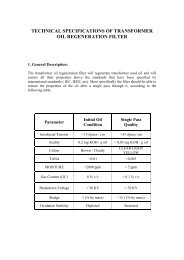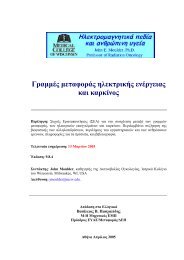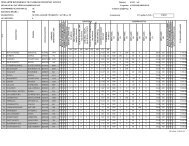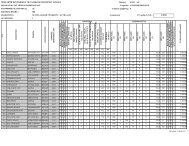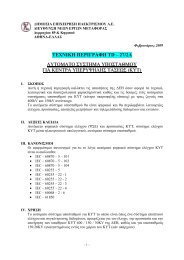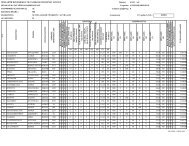Financial Report (January 1, 2010 - December 31, 2010)
Financial Report (January 1, 2010 - December 31, 2010)
Financial Report (January 1, 2010 - December 31, 2010)
Create successful ePaper yourself
Turn your PDF publications into a flip-book with our unique Google optimized e-Paper software.
• The internal revenues of the Distribution Network are recorded based on the charged prices of theDistribution network.• The Supply revenue reflects actual billings to the final consumers.• The Network Administrators revenues are calculated as follows:1. The rental reflects registered billings of the use of the distribution Network.2. The selling energy produced by the Non-interconnected islands to the Supply.3. The Public Service Obligations which are collected and yielded from the Supply to the Administrator ofthe Non-interconnected islands, finally are yielded to the Generation of the Non-interconnected islands.Finally, for the purpose of preparation of the unbundled financial statements, services that PPC receives / rendersto / from the HTSO (ancillary services, energy, etc.) are quantified and presented separately, and not on a netbasis, a practice which is applied by PPC through the preparation process of its consolidated financial statements.Settlement of Economic Differences between General Division of Generation and General Division ofSupply from transaction of Electric EnergyAs it is known, in the context of operation of wholesale market of electric energy, the activity of the GeneralDivision of Supply is debited with the supply of electric energy on the Marginal Price of the System (SMP), whichis then invoiced to the customers on the basis of regulated tariffs, resulting in a substantial divergence betweenincome and expenses. Respectively, the activity of the General Division of Generation is credited by the market onthe basis of SMP..The applied methodology allows the settlement of economic relations between the activity of the General Divisionof Generation and the General Division of Supply and it functions at way similar with the “Contracts of Differences”as foreseen by the provisions of article 230 of the code. Given that PPC constitutes a single legal entity,practically, the particular methodology corresponds to a process of internal pricing between the two activities and itaims in the internal correction of debits and credits of Supply and Generation respectively, that result from thewholesale market.Description of basic methodologyThe methodology that is applied is summarized as follows:The activity of the General Division of Generation and the activity of the General Division of Supply, in the contextof the up coming year’s budget, agree in trading specific quantities of electric energy by zone of charge (Base,Intermediate, Peak) and time period (Winter/<strong>December</strong> – <strong>January</strong> – February – March, Summer/June – July –August – September, Remaining Months) in specific prices. In other words, they agree a total price by zone ofcharge and time period.The income from the trading in question added up to the income from the Transient Capacity AssuranceMechanism (article 330 ep. KDS and SIE), the income from the provision of Complementary Services (article 328KDS and SIE) and the income from variable cost of Generation Units (article 326 KDS and SIE) cover thereasonable cost of the activity of the General Division of Generation, as this results from the unbundled budget ofthe particular year, including a reasonable return on the capital employed.In this context, the price of the settlement of economic differences between the two activities, the General Divisionof Generation and the General Division of Supply, is equal to the product of the difference between the calculatedmiddle price of clearing and the agreed price multiplied by the produced quantity. Continuously, in case that thecalculated middle price of clearing is bigger than the agreed price, then the return of the additional income goesfrom the the activity of the General Division of Generation to the activity of the General Division of Supply, but inthe opposite case, it goes in reverse order.In case of divergence from the agreed, there will be clauses of readjustment of the agreed price. More specifically:• If the prices of liquid fuels and natural gas change, the prices that were agreed upon for the transactionwill be readjusted, on the basis of the provided readjustment of prices of sale of electric energy to thirdparties via the clauses of fuel readjustment.• If the agreed quantities of electric energy change, there will be anticipated correction of the agreed pricevia clauses for the reimbursement of the relative cost of each side.Lignite Supply ContractThe lignite supply contract determines the internal lignite market, i.e the lignite sales of the activity of the LigniteGeneral Division to the activity of the Generation General Division. The contract has to do with the consumption ofthe lignite stations on a continuous basis, as well as with the necessary stock for the specific period. Thecalculation of the relative amounts takes place on the monthly basis, taking into account the monthly consumptionand the calorific value of the lignite delivered.141







